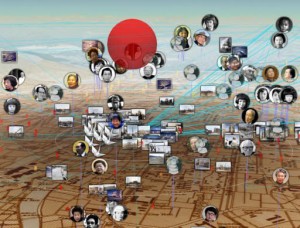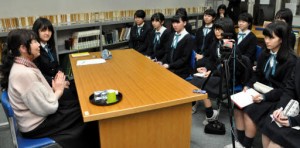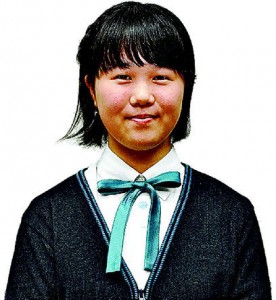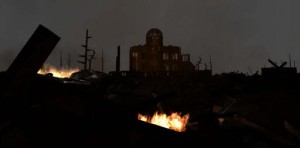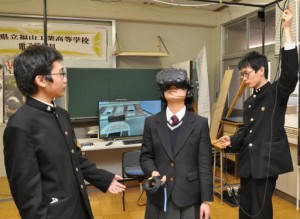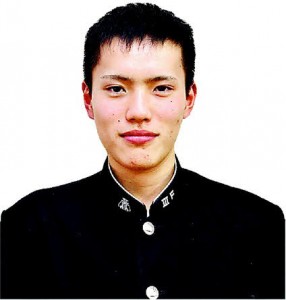Peace Seeds: Teens in Hiroshima Sow Seeds of Peace (Part 52)
Jan. 18, 2018
Part 52: Conveying the A-bomb experience with digital devices
This year marks the 73rd anniversary of the atomic bombing of Hiroshima and efforts to share the A-bomb experience are continuing in many ways. Some high school students in Hiroshima Prefecture are currently seeking to convey this experience by making use of new digital technology.
Students at Hiroshima Jogakuin Senior High School, located in Naka Ward, have created a website called “Hiroshima Archive,” which features a 3D map with videos of A-bomb survivors’ accounts and photos related to the atomic bombing. Through this website, people from around the world can learn about Hiroshima without visiting the A-bombed city.
Meanwhile, students at Fukuyama Technical High School, located in Fukuyama, Hiroshima Prefecture, have reproduced the area of the A-bomb hypocenter with a virtual reality video. They want to give viewers a simulated experience of before and after the atomic bombing so they will understand the horror of the A-bomb attack.
Though they have used some of the latest approaches, the first stage of all these projects is the same: Listening to the experiences of the A-bomb survivors. The challenge is how to convey the suffering and despair of those who endured this tragedy with the use of digital technology.
Hiroshima Jogakuin Senior High School: Website features 3D map with videos of A-bomb survivors’ accounts
The Hiroshima Archive website has been created mainly by students at Hiroshima Jogakuin Senior High School who are members of a signature drive by students of the school, gathering signatures from the public in support of nuclear abolition. In 2011, they began to assemble the Hiroshima Archive with the help of Hidenori Watanabe, an associate professor at Tokyo Metropolitan University. In all, they collected the A-bomb accounts of more than 170 people.
The website can be accessed by the public through the use of personal computers and smartphones and includes functions that enable visitors to search by the name of a location and also leave comments. The students also created a workbook for other students visiting Hiroshima on school trips, helping them to prepare for their trip, carry out activities while in town, and reflect on these experiences. (Hisashi Iwata, 16)
Delving into her painful past
The students videotaped about 50 of the accounts of the A-bomb susrvivors. Last December, they interviewed Chieko Kawashima, 73, a resident of Nishi Ward, who experienced the atomic bombing when she was just eight months old.
The interview last 1.5 hours. “A doctor once told me that I wouldn’t live to the age of 20, but I managed to go on with the support of my friends,” Ms. Kawashima said. “When my mother-in-law found out that I was an A-bomb survivor, she told me to leave the house.” As the students videotaped her testimony, they delved deeper into her story by asking questions like “How did you hold out even when you nearly lost hope to go on living?” and “What sort of peace activities should we be involved in?” The students plan to edit the video of Ms. Kawashima and make it available at the website.
The students are also making efforts to colorize old black-and-white photos. They borrow family photos from A-bomb survivors and scan the images. The students are able to colorize the photos, but some are sent to Professor Watanabe for his help in making the images more clear. The photos are then ready after retouching and gaining the approval of the survivors.
The students say that colorizing the photos captures the interest of young people so they can become more familiar with the experiences of the atomic bombing, which they tend to see as a thing of the past. The colorized photos also help jog the memories of the survivors. (Kotoori Kawagishi, 15, and Kota Ueda, 14)
Interview with Yuuna Sugino, 17, second-year student at Hiroshima Jogakuin Senior High School and the leader of the Hiroshima Archive project
As we edit the videos of the A-bomb survivors’ stories, we take into account the pauses in the interviews. When viewers see the survivors struggling for words or shedding tears, they can appreciate how difficult their lives have been. Hearing the survivors’ voices, and seeing their expressions, are important advantages of the videotaped interviews. I want to know what the world thinks about peace from the messages that have been posted at their website. (The interviewer was Hisashi Iwata, 16)
Fukuyama Technical High School: Reproducing the A-bomb horror through virtual reality
In 2016, the computation skills research club at Fukuyama Technical High School began to create a virtual reality video that reproduces the hypocenter area. The video compresses what happened before and after the atomic bombing from one hour to five minutes, showing an area of about 900 meters.
In order to produce an accurate video, the students read books, studied photographs, listened to the stories of A-bomb survivors, and determined the exact locations and sizes of the buildings. They were particular, too, about the texture of the walls of buildings, the red rust on bicycles, and the reflections of light on tiles and on the water in fire cisterns because such textures and weathering creates a sense of real life.
Previously, the students created a reproduction of Hiroshima before the A-bomb attack, but they felt the result wasn’t powerful enough to appeal to the five senses. They were frustrated with the limits of the technology they had. They subsequently purchased a virtual reality device that had previously been very expensive, and the prototype of their virtual reality video has been made available to the public in the United States. The students are now seeking to complete this version over the next two years and they hope that it will serve as a bridge between that day and today. (Kana Okino, 17)
Simulated experience of daily life that was lost
When I put on the special virtual reality goggles and earphones, I was able to experience the virtual space of the atomic bombing. I will never forget those five minutes, which I experienced with my own eyes and ears.
I started from the front of the Hiroshima Prefectural Industrial Promotion Hall. Looking up at the beautifully curved white gate, I went north along the Motoyasu River. I stopped in front of a sweets shop in Sarugaku-cho. There were chocolates and candies on display. The children of those days would have been excited to see these sweets on the shelves.
Hearing the buzzing sound of cicadas, I went to Saiku-machi on the south side and saw the Shima Hospital ahead of me on the left. Noticing a low-pitched sound, I looked up at the blue sky and found an airplane the size of a grain of rice. Suddenly, I was engulfed in a flash of white light. I instinctively murmured, “Oh!” I then heard a tremendous roar. This was the moment when the atomic bomb exploded in the sky above the city.
The daylight disappeared and my surroundings went dark. Fires began to blaze up and I could gradually make out the heaps of debris all around me. Flames were raging from the buildings that now consisted of only iron framework. Hearing the roaring fire and howling wind, I couldn’t help feeling anxious and fearful.
I wanted to take off my goggles right then, but I was startled at the thought that I knew I could return to a peaceful world, but the people who were actually there, at the atomic bombing, had no way of escaping. How painful and frightening that must have been for them! It made me think deeply about how important it is to prevent this tragedy from fading away. (Kana Okino, 17)
Interview with Tsubasa Hirata, 18, third-year student and the former president of the computation skills research club at Fukuyama Technical High School
When I saw A-bomb survivors as they tearfully recounted their experiences, I recognized that this isn’t someone else’s problem, and this is what prompted my own efforts. Some people who experienced the virtual reality video, which is a reproduction of the atomic bombing, have felt dumbstruck or stopped it the middle. The fact that this virtual reality video can get people to understand the real horror of the atomic bombing makes it a highly significant project. (The interviewer was Ai Mizoue, 15)
Hidenori Watanabe, 43, associate professor at Tokyo Metropolitan University: Continue listening to the survivors’ experiences
In the past, only adults could bear the expense of using information technology so freely, but now high school students are able to use it easily, too, without spending a lot of money.
A growing number of people are able to access the Hiroshima Archive over the Internet, and the colorized photos are capturing their interest. The virtual reality video, which reproduces the conditions of the hypocenter area, is also a unique way to convey the A-bomb reality by young people. There will be more new ways as technology continues to progress.
But using the latest technology and listening to the people who experienced that time can’t be separated. Teenagers today will be the last generation able to talk directly to the A-bomb survivors. I hope these young people will create an accurate record and that their video will move people to visit the A-bombed city. (The interviewer was Kota Ueda, 14)
Junior writers’ impressions
The theme for this article was “Conveying the A-bomb experience with digital devices.” I felt strongly about this theme and proposed it again and again. When I experienced the virtual reality video, and was moving through Hiroshima in the aftermath of the bombing, I recalled each of the survivors’ accounts I’ve heard: “It was a picture of hell” and “I searched for my family but had no idea where to look.” I couldn’t help crying. We can only imagine that day, but I hope that we’ll be able to imagine it more accurately and vividly, even if just a little, with the help of new technology, to hand down the survivors’ memories of the atomic bombing. The virtual reality video, made by the students of Fukuyama Technical High School, clearly took a lot of thought and effort. (Kana Okino)
I gathered information about the virtual reality video made by the students at Fukuyama Technical High School. This video, which the students did their best to create, made me feel like I was actually in front of the Atomic Bomb Dome on August 6, 1945, and I understood the horror of the atomic bomb. With opportunities to listen directly to the A-bomb survivors decreasing, I think the virtual reality video is an important way to help prevent the memories of the atomic bombing from fading. (Ai Mizoue)
I interviewed Hidenori Watanabe, an associate professor at Tokyo Metropolitan University. He said that the Internet had become commonplace, and now it was difficult for individuals to get to know things that are outside the scope of their own interests. Mr. Watanabe has been helping to create the Hiroshima Archive and colorizing the photos of A-bomb survivors because he wants people who have little interest in the war to become more aware of these issues. To be honest, these days I’ve only been using the Internet to look at things that already interest me. I think it’s important to see something from several viewpoints and this was an opportunity to learn about a topic that’s unfamiliar to me, seeing it from different perspectives. I think the Hiroshima Archive is an important project. (Kota Ueda)
What is Peace Seeds?
Peace Seeds are the seeds of smiles which can be spread around the world by thinking about peace and the preciousness of life from various viewpoints. To fill this world with flowering smiles, the junior writers, 25 junior high school and senior high school students, choose themes, gather information, and write articles.
(Originally published on January 18, 2018)
This year marks the 73rd anniversary of the atomic bombing of Hiroshima and efforts to share the A-bomb experience are continuing in many ways. Some high school students in Hiroshima Prefecture are currently seeking to convey this experience by making use of new digital technology.
Students at Hiroshima Jogakuin Senior High School, located in Naka Ward, have created a website called “Hiroshima Archive,” which features a 3D map with videos of A-bomb survivors’ accounts and photos related to the atomic bombing. Through this website, people from around the world can learn about Hiroshima without visiting the A-bombed city.
Meanwhile, students at Fukuyama Technical High School, located in Fukuyama, Hiroshima Prefecture, have reproduced the area of the A-bomb hypocenter with a virtual reality video. They want to give viewers a simulated experience of before and after the atomic bombing so they will understand the horror of the A-bomb attack.
Though they have used some of the latest approaches, the first stage of all these projects is the same: Listening to the experiences of the A-bomb survivors. The challenge is how to convey the suffering and despair of those who endured this tragedy with the use of digital technology.
Hiroshima Jogakuin Senior High School: Website features 3D map with videos of A-bomb survivors’ accounts
The Hiroshima Archive website has been created mainly by students at Hiroshima Jogakuin Senior High School who are members of a signature drive by students of the school, gathering signatures from the public in support of nuclear abolition. In 2011, they began to assemble the Hiroshima Archive with the help of Hidenori Watanabe, an associate professor at Tokyo Metropolitan University. In all, they collected the A-bomb accounts of more than 170 people.
The website can be accessed by the public through the use of personal computers and smartphones and includes functions that enable visitors to search by the name of a location and also leave comments. The students also created a workbook for other students visiting Hiroshima on school trips, helping them to prepare for their trip, carry out activities while in town, and reflect on these experiences. (Hisashi Iwata, 16)
Delving into her painful past
The students videotaped about 50 of the accounts of the A-bomb susrvivors. Last December, they interviewed Chieko Kawashima, 73, a resident of Nishi Ward, who experienced the atomic bombing when she was just eight months old.
The interview last 1.5 hours. “A doctor once told me that I wouldn’t live to the age of 20, but I managed to go on with the support of my friends,” Ms. Kawashima said. “When my mother-in-law found out that I was an A-bomb survivor, she told me to leave the house.” As the students videotaped her testimony, they delved deeper into her story by asking questions like “How did you hold out even when you nearly lost hope to go on living?” and “What sort of peace activities should we be involved in?” The students plan to edit the video of Ms. Kawashima and make it available at the website.
The students are also making efforts to colorize old black-and-white photos. They borrow family photos from A-bomb survivors and scan the images. The students are able to colorize the photos, but some are sent to Professor Watanabe for his help in making the images more clear. The photos are then ready after retouching and gaining the approval of the survivors.
The students say that colorizing the photos captures the interest of young people so they can become more familiar with the experiences of the atomic bombing, which they tend to see as a thing of the past. The colorized photos also help jog the memories of the survivors. (Kotoori Kawagishi, 15, and Kota Ueda, 14)
Interview with Yuuna Sugino, 17, second-year student at Hiroshima Jogakuin Senior High School and the leader of the Hiroshima Archive project
As we edit the videos of the A-bomb survivors’ stories, we take into account the pauses in the interviews. When viewers see the survivors struggling for words or shedding tears, they can appreciate how difficult their lives have been. Hearing the survivors’ voices, and seeing their expressions, are important advantages of the videotaped interviews. I want to know what the world thinks about peace from the messages that have been posted at their website. (The interviewer was Hisashi Iwata, 16)
Fukuyama Technical High School: Reproducing the A-bomb horror through virtual reality
In 2016, the computation skills research club at Fukuyama Technical High School began to create a virtual reality video that reproduces the hypocenter area. The video compresses what happened before and after the atomic bombing from one hour to five minutes, showing an area of about 900 meters.
In order to produce an accurate video, the students read books, studied photographs, listened to the stories of A-bomb survivors, and determined the exact locations and sizes of the buildings. They were particular, too, about the texture of the walls of buildings, the red rust on bicycles, and the reflections of light on tiles and on the water in fire cisterns because such textures and weathering creates a sense of real life.
Previously, the students created a reproduction of Hiroshima before the A-bomb attack, but they felt the result wasn’t powerful enough to appeal to the five senses. They were frustrated with the limits of the technology they had. They subsequently purchased a virtual reality device that had previously been very expensive, and the prototype of their virtual reality video has been made available to the public in the United States. The students are now seeking to complete this version over the next two years and they hope that it will serve as a bridge between that day and today. (Kana Okino, 17)
Simulated experience of daily life that was lost
When I put on the special virtual reality goggles and earphones, I was able to experience the virtual space of the atomic bombing. I will never forget those five minutes, which I experienced with my own eyes and ears.
I started from the front of the Hiroshima Prefectural Industrial Promotion Hall. Looking up at the beautifully curved white gate, I went north along the Motoyasu River. I stopped in front of a sweets shop in Sarugaku-cho. There were chocolates and candies on display. The children of those days would have been excited to see these sweets on the shelves.
Hearing the buzzing sound of cicadas, I went to Saiku-machi on the south side and saw the Shima Hospital ahead of me on the left. Noticing a low-pitched sound, I looked up at the blue sky and found an airplane the size of a grain of rice. Suddenly, I was engulfed in a flash of white light. I instinctively murmured, “Oh!” I then heard a tremendous roar. This was the moment when the atomic bomb exploded in the sky above the city.
The daylight disappeared and my surroundings went dark. Fires began to blaze up and I could gradually make out the heaps of debris all around me. Flames were raging from the buildings that now consisted of only iron framework. Hearing the roaring fire and howling wind, I couldn’t help feeling anxious and fearful.
I wanted to take off my goggles right then, but I was startled at the thought that I knew I could return to a peaceful world, but the people who were actually there, at the atomic bombing, had no way of escaping. How painful and frightening that must have been for them! It made me think deeply about how important it is to prevent this tragedy from fading away. (Kana Okino, 17)
Interview with Tsubasa Hirata, 18, third-year student and the former president of the computation skills research club at Fukuyama Technical High School
When I saw A-bomb survivors as they tearfully recounted their experiences, I recognized that this isn’t someone else’s problem, and this is what prompted my own efforts. Some people who experienced the virtual reality video, which is a reproduction of the atomic bombing, have felt dumbstruck or stopped it the middle. The fact that this virtual reality video can get people to understand the real horror of the atomic bombing makes it a highly significant project. (The interviewer was Ai Mizoue, 15)
Hidenori Watanabe, 43, associate professor at Tokyo Metropolitan University: Continue listening to the survivors’ experiences
In the past, only adults could bear the expense of using information technology so freely, but now high school students are able to use it easily, too, without spending a lot of money.
A growing number of people are able to access the Hiroshima Archive over the Internet, and the colorized photos are capturing their interest. The virtual reality video, which reproduces the conditions of the hypocenter area, is also a unique way to convey the A-bomb reality by young people. There will be more new ways as technology continues to progress.
But using the latest technology and listening to the people who experienced that time can’t be separated. Teenagers today will be the last generation able to talk directly to the A-bomb survivors. I hope these young people will create an accurate record and that their video will move people to visit the A-bombed city. (The interviewer was Kota Ueda, 14)
Junior writers’ impressions
The theme for this article was “Conveying the A-bomb experience with digital devices.” I felt strongly about this theme and proposed it again and again. When I experienced the virtual reality video, and was moving through Hiroshima in the aftermath of the bombing, I recalled each of the survivors’ accounts I’ve heard: “It was a picture of hell” and “I searched for my family but had no idea where to look.” I couldn’t help crying. We can only imagine that day, but I hope that we’ll be able to imagine it more accurately and vividly, even if just a little, with the help of new technology, to hand down the survivors’ memories of the atomic bombing. The virtual reality video, made by the students of Fukuyama Technical High School, clearly took a lot of thought and effort. (Kana Okino)
I gathered information about the virtual reality video made by the students at Fukuyama Technical High School. This video, which the students did their best to create, made me feel like I was actually in front of the Atomic Bomb Dome on August 6, 1945, and I understood the horror of the atomic bomb. With opportunities to listen directly to the A-bomb survivors decreasing, I think the virtual reality video is an important way to help prevent the memories of the atomic bombing from fading. (Ai Mizoue)
I interviewed Hidenori Watanabe, an associate professor at Tokyo Metropolitan University. He said that the Internet had become commonplace, and now it was difficult for individuals to get to know things that are outside the scope of their own interests. Mr. Watanabe has been helping to create the Hiroshima Archive and colorizing the photos of A-bomb survivors because he wants people who have little interest in the war to become more aware of these issues. To be honest, these days I’ve only been using the Internet to look at things that already interest me. I think it’s important to see something from several viewpoints and this was an opportunity to learn about a topic that’s unfamiliar to me, seeing it from different perspectives. I think the Hiroshima Archive is an important project. (Kota Ueda)
What is Peace Seeds?
Peace Seeds are the seeds of smiles which can be spread around the world by thinking about peace and the preciousness of life from various viewpoints. To fill this world with flowering smiles, the junior writers, 25 junior high school and senior high school students, choose themes, gather information, and write articles.
(Originally published on January 18, 2018)

